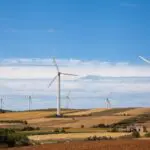
Portugal to start building its largest wind farm in 2025
The new wind farm will have a capacity of 274 megawatts (MW), which is equivalent to the annual energy needs of 128 000 homes. Portugal’s
According to REN, the new record was driven by “the growth of renewable installations and the overall favorable conditions”.
Renewable energies will supply 71% of national electricity consumption in 2024, totaling 36.7 TWh (terawatts per hour), says REN – Redes Energéticas Nacionais in a statement. This is the highest figure ever for the Portuguese electricity system, surpassing the previous high recorded in 2023, when renewable production supplied 61% of electricity consumption, totaling 31.2 TWh.
The new milestone was driven by “the growth of renewable installations and the overall favorable conditions”, REN points out.
Although the end of 2024 saw lower hydroelectric production, the hydropower capability index was 1.16 (above the historical average of 1.0), while wind power was 1.06 (above the historical average of 1.0) and solar production was 0.94 (below the historical average of 1, due to “less favorable conditions”, REN explains).
“Hydroelectric and wind power plants had similar weights in supplying the national system, with 28% and 27% respectively, while photovoltaics were close to 10% and biomass 6%. Particularly noteworthy was the year-on-year growth of 24% in hydroelectric production and 37% in photovoltaics, which had the highest share ever in national consumption, due to the strong expansion of this technology in the national electricity system,” reads the statement.
“2024 will go down in history as a year of two energy records: the highest production of renewable electricity and the lowest carbon dioxide emissions ever in total electricity production. Between 2023 and 2024, carbon dioxide emissions were reduced from 3.7 to 1.9 million tons, 1.8 million tons less, approximately 48% less,” estimates Associação ZERO, in a statement.
As far as non-renewable production is concerned, it was practically all natural gas, which amounted to 5.1 TWh (10% of consumption), the lowest figure since 1979, when non-renewable production was essentially fuel oil.
“Natural gas production has decreased its penetration, both due to the growing availability of renewable energy, but also due to the import balance, which in 2024 totaled 10.5 TWh, the highest ever in the national electricity system, and which made it possible to supply 20% of national consumption,” explains REN.
“In the natural gas market, consumption in 2024 totaled 40.5 TWh, down 17% on the previous year, the lowest annual consumption since 2003. While the electricity production segment continued the downward trend of recent years, with a sharp contraction of 56%, the conventional segment, which covers all other consumers, saw year-on-year growth of 2%, the first positive record after four consecutive years of falling consumption,” says REN.
In 2024, the national system was supplied almost entirely from the Sines Liquefied Natural Gas terminal, with gas coming mainly from Nigeria (53%) and the United States (41%).
REN also points out that 2024 was “the second year with the highest consumption ever in the national electricity system, only surpassed by around 2% by the all-time high in 2010. Last year, electricity consumption supplied from the public grid totaled 51.4 TWh, up 1.3% on the previous year (2.0% when correcting for the effects of temperature and the number of working days).”


The new wind farm will have a capacity of 274 megawatts (MW), which is equivalent to the annual energy needs of 128 000 homes. Portugal’s

The ENERGÉTICO website provides information, consumption and cost simulators, energy-saving tips and a tool to guide social workers in advising low-income families. “ENERGÉTICO” is the

Turismo de Portugal conducted a survey on the environmental performance of tourist accommodations. There are concrete measures for saving water and energy, but there is

This artical addresses an action that promotes theinssurance of universal access to affordable, renewable energy for all. SDG 7 also claims to double the global rate of improvement in energy efficiency.
 To discover businesses that are actively working to contribute to this Sustainable Development Goal, click here.
To discover businesses that are actively working to contribute to this Sustainable Development Goal, click here. To read news, interviews or tips related to this Goal, click here.
To read news, interviews or tips related to this Goal, click here.Esta publicação também está disponível em:
![]() Português (Portuguese (Portugal))
Português (Portuguese (Portugal))